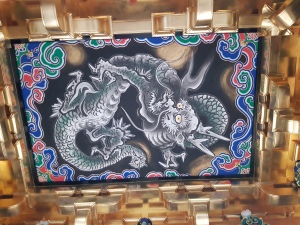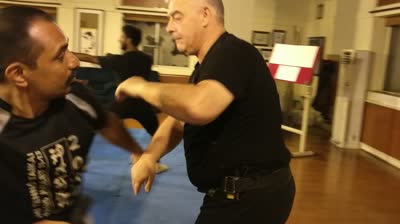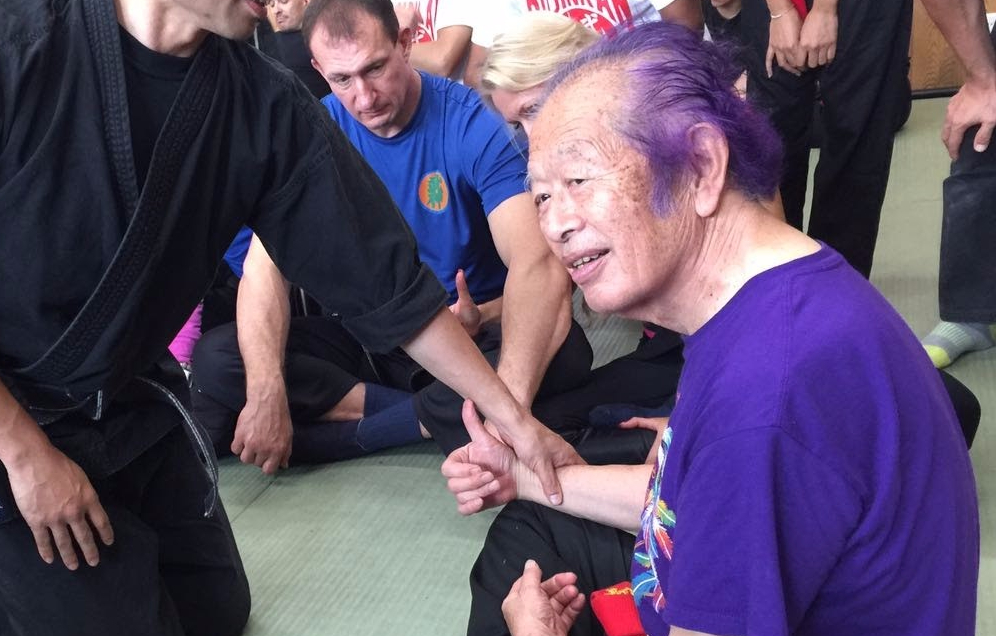From Shiro Kuma by kumablog
“Mutō Dori is about controlling, not fighting!” said sensei, once again, at the beginning of the class.
But what does he mean? Here some beginning of an explanation.
Watching and listening carefully, I understood the following: Sensei uses his finger(s) as a contact point(s) with the attacker. The contact(s) act as a Shiten, fulcrum. (1)
Once the connection established, Hatsumi sensei only rotates around the fulcrum, and reposition his whole body in a dynamic flow, and in slow motion. Slow is the key.
Since we studied the proprioceptive abilities of the human brain, we know that “speed” is perceived more or less accurately if the shape (your body) is still in view.
Big shape vs. small speed = shape is what matters; small shape vs. big speed = speed is what is important to the brain. (2)
When Sensei touches Uke with one finger, this point of contact becomes the axis of rotation. But what I noticed in class, is that Sensei is not pivoting from this point, he’s turning the whole body around it. That is the difference between Mawashi and Mawari. In Mawashi you pivot from the axis; in Mawari you walk around the axis. Using the image of a merry-go-round, it rotates on the axis, but you on the horse are turning around. We studied that in 2003 with the Kunai.
When you attack sensei, you have the feeling that you’re going to hit him because it seems to you that he’s not moving at all. But the moment you think you hit him, he is not there, and you’re defeated. His movements are slow, but his timing, his distance, and the rhythm of his movements are perfect. He’s like a plane flying under the radar.
This perfection is achieved with what he called “Zentai”, full body movement. (4)
He’s not only walking away at the ideal moment, but he’s also moving his shoulders up and down in a wave-like motion. Noguchi sensei made me aware of this “kata Nami” movement, “look at the shoulders” he told me. And I saw it. Without his help in not sure I would have seen it. (5)
During the whole class, Sensei insisted that we have to use the subconscious mind instead of the
conscious mind to be able to flow naturally the way he does.
I understand, but I’m unable to do it. That is the next level.
Ganbate
_________________
1. Shiten: 支点, Fulcrum
2. Proprioception: Here’s a short reminder. The human brain processes the information following the importance of the “5S”: Shape, Speed, Sound, Spectrum (colour), Smell.
As long as your visibility is more important to the attacker’s brain and sight, that your slow movements, he will not “see” you moving. Technically you’re “invisible”. Conversely, if you speed up your movements, they will get more important for his brain, and he will counter your actions.
3. Mawari: 回り, rotation, around,
Mawashi: 回す, to turn; to rotate; to gyrate, to surround.
Please note that the kanji are identical. It is the conceptual scheme that differs here.
4. Zentai: 全体, whole; entirety; whatever (is the matter) / here: the whole body
5. Kata Nami:
波, wave + 肩, shoulder; To roll the shoulder up and down to open Uke
6.潜在意識, Senzaiishiki, subconscious (awareness)


…




















